Performance engine tuning modifications.
"Don't torque to me like that!"
Careful selection of your internal engine tuning modifications can lift your engine from a purring kitten into a roaring lion!
While it is tempting to throw in every modification you can, it's worth noting that not all mods work well together. This is something we cover in our articles as we steer you to the right decision on mods for your car. There is also a lot of hype around car mods which we aim to cut right through leaving you with a realistic and common sense oriented engine tuning guide.
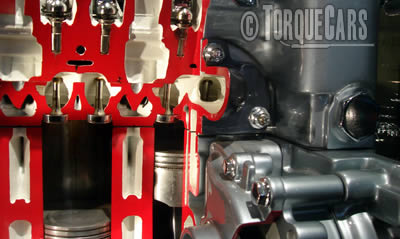
For example a gas flowed head with a sport cam actually produces less power than it would with just one of the two modifications. This is where the cam profile is not carefully matched to the head flow rate. Also some modifications should be done together to achieve more power than the sum total of the individual parts.
You want to avoid ending up with a high peak BHP power engine that has an unusable narrow torque band. Peak power is only part of the figure, one should really look at the torque curve and aim to get this as flat and wide as possible for a predictable power delivery. A lot depends on the engine configuration and the driver/driving conditions to be encountered.
So how do you make a car go faster? Aside from pushing the accelerator pedal harder there are some basic things that can be done. The internal combustion engine works on the principle suck,squish, bang, blow. The more efficiently it can burn the fuel the better the power output will be.
Air is drawn in to the engine (this is the suck stage) then it is mixed with Fuel and compressed (the squish stage) – then along comes a bright spark and the intake charge ignites (the Bang phase) is achieved – releasing all that compressed energy which forces the piston down and the air out of the engine along the exhaust (this is the Blow stage).
It is possible to blow huge amounts of money on a car ruining it and suffering from repeated mechanical failures, higher running costs and lack of day to day driveability. TorqueCars intends to assist you in deciding which mods to do. We are thoroughly committed to give you a realistic opinion of what the car will end up like and we give a common sense guide on the pitfalls and common mistakes to avoid.
Our forum is a great place to learn more about car tuning and styling where you will find lots of very friendly and helpful people.
Track cars are rebuilt each time they are raced and they are set up for optimum conditions on the flat surface of the track - we have to tune our cars to work for a year without a service, run over potholes and speed humps and cope with a variety of weather conditions and loads. We need to establish the sensible mods that will cope with everyday driving but help you to get the maximum enjoyment from it.
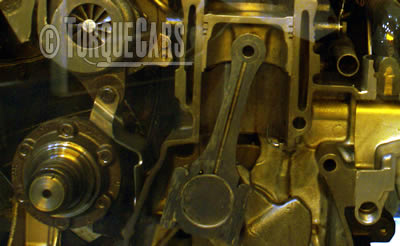
Breathing mods (Intake and exhaust).
The most popular and easiest DIY mods are those that improve the "breathing" of the engine. The stock induction and exhaust can in some cases noticeably restrict the power of the engine so getting these right with higher flowing parts can make a big difference. However induction kits and big bore exhausts are the most misunderstood performance parts and by getting the selection wrong you can lose power. Read more on breathing mods.
Internal engine tuning modifications
Items include high compression pistons (increase the compression ratio).
Low compression pistons (reduce the compression ratio and used with some turbo applications to prevent ignition problems and reduce the effects of turbo lag.
Skimming the head also increases the compression ratio and to avoid detonation with low octane fuel a low compression piston is used. Read more on internal engine mods
Gas flowed head
The internals of the head are polished and channelled to allow the induction charge and exhaust gases to flow more freely. Inlet diameter and other measurements are taken and the best flow rate is calculated and the engine channelled out accordingly smoothing the internals and sometime a little turbulence/swirl is added to ensure a good air/fuel mix inside the combustion chambers.
Specialists can increase EITHER the peak torque/bhp output of the engine which gives a nice headline figure or spread the peak Torque/bhp band which gives a much improved drive. We would say to ignore the peak power figure and look at getting a nice wide and flat Torque band across the rev range for everyday driving. In motorsport you will be using the high rpm bands and this is where you want the power to be.
You can also have EITHER improved fuel economy and a slightly lower power figure or tune the engine to the max and get reduced fuel consumption. (Obviously you get both if an engine is of an inefficient design but generally speaking you can't have more power and better economy through head flowing) Sadly you can't have everything you have to decide what the optimum rev range that you use is then specific gains can be generated in that area by flowing the head.
The angle of the inlet valves and the angle of the area around them is also critical. Enlarging the inlet and exhaust valves and increasing the lift on the valve can all aid the way gases flow into and around the head. Read more on Porting and polishing.
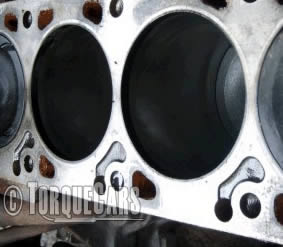
Rebores
The cylinders to create a higher capacity engine – check that your engine management system is able to cope or can be adjusted to suit this will also require work on the pistons as they will need to be switched for wider ones. A stroker kit also increases the cylinder capacity and typically comprises con rods, crank and pistons and generates more space in the cylinders for air and fuel. Not all engines are suitable for reboring, notably those made from aluminium with liners in the cylinders but most cast blocks can be rebored to a higher capacity after a stress test is performed. More on engine rebores
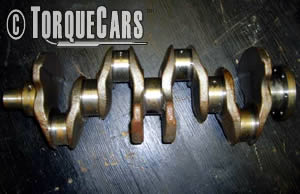
Crank grind/polish
While the crank is ground it is worth balancing all of the other internals of the engine - your redline will be higher if the engine is balanced and a lighter polished crank gives less friction and releases more power from the engine. The balancing allows you to run higher RPM levels safely without nasty vibrations in the engine.
Sport computer tuning (Remapping, Chipping and Flashing)
This changes the timing characteristics of the engine and is usually perfectly matched to your engine, fuel choice, driving style and car condition rather than the standard makers best guess setup which can cope with pretty bad servicing and poor quality fuel. Massive power gains and better fuel economy are available (particularly on turbo diesel models) as is a high revs sport power setting and a low revs economy setting.
The downside is that you have to keep the engine in peak condition changing the plugs regularly and fastidiously following the service intervals. The cars which benefit the most from a sport computer are those which are fitted with a turbo or supercharger.
You can buy a standard plug in chip but it is much better to have your ECU (engine control unit or engine management unit) set up specifically for your engine and have a custom map. Again this can be set up to give better fuel economy, a lower peak torque cure, better acceleration or higher top end power. Some ECU's are impossible to reprogram without the manufacturers diagnostic equipment - the Rover MEMS is a point in case and Toyota have effectively locked their ECU's.
If this is the case with your engines computer you can add a piggyback device which gives false readings to your cars ECU and takes over control of Fuel, Ignition and boost control. More on ECU tuning
Port Matching
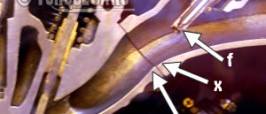 Port matching adjusts the diameter of the exhaust and inlet ports to match the profile on the manifolds which are nearly always bigger.
Port matching adjusts the diameter of the exhaust and inlet ports to match the profile on the manifolds which are nearly always bigger.
(Don't take out the V groove completely as the torque will drastically reduce!
The aim is to allow a smoother flow of air without the turbulence associated with having a step between the mating surfaces.
It is possible to do a DIY on a standard engine but performance engines will only see gains when machined on a proper flow bench. More on port matching
Camshafts
A sport or fast road camshafts increase the duration of the valves opening and closing the engine is best suited to higher revs and can cause a stodgy tick over. Cam profiles vary from fast road to full race. One of the most cost effective and noticeable modifications you can do. We explain the many profiles available and the typical effect it will have on performance. More on camshafts
Forced air induction.
A turbo or supercharger forces air into the engine at a greater pressure and more air and more fuel = bigger bang = more power. Turbo chargers use the force of the expelled exhaust to drive a turbine and ram fresh air into the engine. Superchargers however are driven by the engines drivetrain but both turn relatively small engines into real powerhouses.
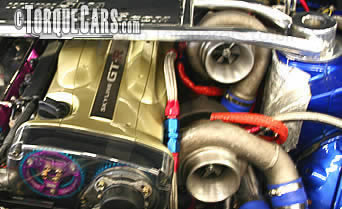
Superchargers give a noticeable power increase at all revs. Because the supercharger is driven by the engine higher RPM's mean more air is sucked in. Some manufacturers are introducing superchargers to their turbo engines to minimise lag and eek out every drop of available power. By altering the pulleys on the supercharger you can effectively overdrive it boosting power and we see a lot of superchargers fitted to large v8 engines.
Turbo chargers produce more power than supercharges but are subject to lag. More and more manufacturers are adding turbos to their cars and there is a growing trend of fitting aftermarket turbo kits as well. The fuel injectors would need to run at a higher pressure and other aspects of the engine would need to be strengthened but a stock turbo engine can usually safely handle 30% more power. More on Forced induction
Fuelling
When you increase the power of an engine you will need to increase the amount of fuel it has to work with. You will usually need to uprate the injectors and fuel pump. The mix ratio of air to fuel needs to be closely balanced and most engine tuning projects will involved increasing the amount of fuel and air combusted in the engine. More on fuelling
To discuss all aspects of car tuning in more detail please join our forum.
If you liked this page please share it with your friends, drop a link to it in your favourite forum or use the bookmarking options to save it to your social media profile.
Check out TorqueCars new YouTube channel, and see their awesome new content...
Feedback
Please use our forums if you wish to ask a tuning question, and please note we do not sell parts or services, we are just an online magazine.
Help us improve, leave a suggestion or tip
